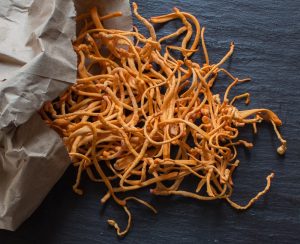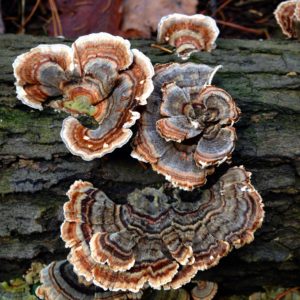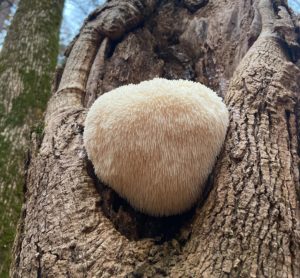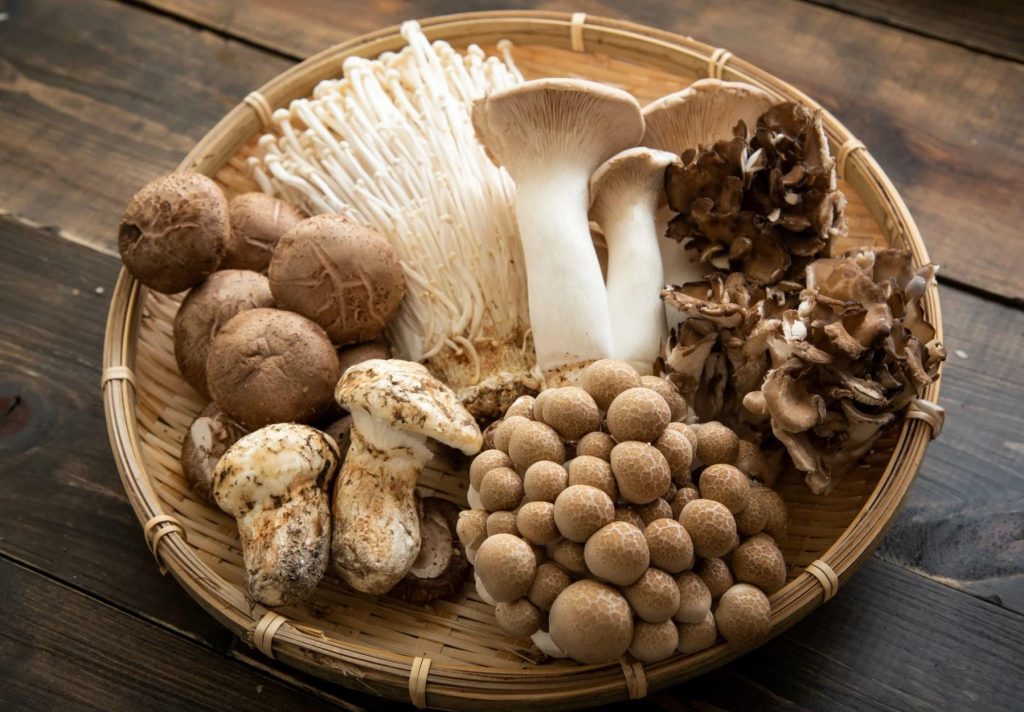What Are Functional Mushrooms?
“Functional mushrooms” are essentially the same thing as medicinal mushrooms, although one could have an interesting discussion as to which term is more accurate and why. One possible reason for calling them “functional” is that some are reputed to have benefits that seem a little different from what we normally rely on medicine to do—rather than curing disease, some (called adaptogens) help the body recover from stress & anxiety. But in general, functional mushrooms are those valued for health benefits other than nutrition.
It’s worth noting that a functional mushroom can have food value also. While not all of these mushrooms work as food, quite a number of them do.
Functional Mushrooms Benefits
The first thing to know about functional mushrooms is that most of their functions haven’t actually been proven. Some writers like to hide this fact. You might see articles claiming that “scientific research shows” that this or that mushroom species cures cancer or diabetes or whatever else. Click on the reference link, though, and you’ll find that the scientific research was a preliminary study involving 14 badly-mistreated rats. Scientific? Yes. Intriguing? Yes. Proof? No, not remotely.
If you’re taking mushrooms, you are taking a chance on something that might work—and there is nothing wrong with that, as long as the treatment is known to be safe. But just be aware that’s what you’re doing.
The vast majority of functional mushrooms owe their possible effectiveness to beta glucans, a group of substances that show real promise in blood-sugar regulation, immune modulation, cancer treatment, and other areas of medicine. Some also show promise as antibiotics. Some have other very specific possible benefits, such as lion’s mane’s promise in promoting the healing of nerve tissue. Some fall under the heading of “adaptogens,” a somewhat amorphous category of mushrooms (and plants) apparently able to improve recovery time from exercise and other forms of physical stress.
Using Functional Mushrooms
There are basically three ways you can take functional mushrooms—but they definitely aren’t equal.
Eating Functional Mushrooms
Some functional mushrooms work as food, so it might seem obvious that cooking with functional mushrooms could be a way to improve your health. Unfortunately, that’s rarely the case. Many mushroom species are very healthy to eat, but they are also mostly water and chitin (the indigestible, stiff substance fungi use for internal support). To derive enough protein, carbohydrate, and vitamins from mushrooms to meet a significant fraction of your daily needs would require eating way more mushrooms than even the most dedicated mycovore is likely to want to do. The situation with beta glucans and other potentially medicinal substances is similar. With rare exceptions, there is no way to get an effective dose without making some kind of concentrated extract.
Functional Mushroom Coffee
The idea of mushroom coffee is pretty simple: mix mushroom extracts or powders in with coffee and serve. There are multiple brands of mushroom coffee available now (the most popular being Four Sigmatic) and each brand offers multiple mushroom species. Unfortunately, there is no solid research on the effectiveness of mushroom coffee. If the medicinal substances within the extracts can survive, without degradation, being processed into coffee (and that’s a big if), these products are probably at least as good for you as taking the extract or powder on its own.
If you’re interested in trying mushroom coffee, choose one for the quality of its extracts, not its product claims, which may be quite inflated. It seems unlikely that mixing with the coffee does anything useful, and at least in some cases, you will likely get less benefit from mushroom coffee than you would from eating whole mushrooms[i].
Some people do claim that drinking mushroom coffee has helped them. Of course, anecdotal claims are rarely proof of anything, but there is a way in which replacing regular coffee with mushroom coffee may indeed help someone’s health; mushroom coffee has less caffeine.
Functional Mushroom Supplements
The third option is to take mushroom supplements. These are extracts of functional mushrooms (not simply powdered whole mushroom). These are probably your best best for getting the benefits of functional mushrooms, though it’s still important to get quality—that is supplements made with hot-water extracts of the fruiting body (not mycelium) by a reputable company. And it’s important to follow the guidance of an experienced practitioner.
Also, please never use functional mushroom supplements instead of medical treatment by a doctor. Use them to support and assist whatever other treatment you might be getting, and do tell your doctor about them. Some functional mushrooms have side effects or possible interactions with certain drugs.
List of Functional Mushrooms
The following list is by no means exhaustive, but it does include some of the more popular functional mushrooms in use today.
Reishi

Reishi is a little tricky, though it doesn’t mean to be. The name originally applied to the species Ganoderma lingzhi, which lives in Asia and has a long history of use in folk medicine there. However, for a long time, all reishi-like Ganodermas of Asia, Europe, and North America were all lumped together as one species under the name, Ganoderma lucidum, a name now applied only to a European species. Some people refer to the entire complex as “Reishi,” which could be legitimate if they acknowledged that there is more than one kind of Reishi—but many don’t. Many writers, some of whom seem to also be either practitioners or supplement sellers or both, treat all the Reishis as medically interchangeable, for which there is no evidence. Worse, it’s not always evident which species was involved in which older study.
So let’s be clear; if you want the mushroom used in Asian folk medicine, that’s G. lingzhi.
Reishi[ii] is a hard, woody polypore mushroom with a shiny, almost lacquer-like upper surface. It can’t be eaten because of its woody texture, but is traditionally made into tea or mixed with wine and used to treat a wide variety of conditions. Its use remains popular, though there is very little scientific evidence to support it. Also, reishi use in large doses or over long time periods can have serious, even dangerous side effects.
Chaga (Inonotus obliquus)

Chaga[iii] is a strange and entirely unpalatable fungus that can be made into tea and has a long history of use in folk medicine of Europe and Asia. Its traditional uses are many, but most have not been scientifically investigated. There is some preliminary evidence for its effectiveness at lowering blood sugar and cholesterol. It might also stimulate the immune system and act as an antioxidant. It is not safe to take in very large doses and could interfere with certain medications.
Cordyceps

Cordyceps is a genus of predatory fungi. Most attack and kill insects, though some go after other fungi instead. Cordyceps militaris and Cordyceps sinensis are both commonly considered adaptogens—whether they can be used interchangeably is a matter of some debate. C. sinensis is the most expensive mushroom in the world.
Turkey Tail (Trametes versicolor)

Turkey Tail[iv] does indeed look like tiny Turkey Tails—fan-shaped with bands of color. The fruiting bodies appear on wood that has been dead for at least three years. It’s fairly common, in some areas, and has a texture similar to dry card stock. While a great many medicinal uses are attributed to it, most are not yet supported by research—however, there is some provisional support for its use in the treatment of certain types of cancer as it appears able to increase the effectiveness of chemotherapy. However do not take Turkey Tail without checking with your oncologist.
Lion’s Mane (Hericium erinaceus)

Lion’s Mane is both a functional mushroom and a culinary mushroom; it tastes rather like crab meat. It’s another unintentionally tricky species, for it has several close relatives that taste more or less the same, and some people regard the whole group as medicinally interchangeable as well—and for all we know, they could be, but it’s also quite possible that they are not. The research hasn’t been done. So if you want the Lion’s Mane that has been studies, be sure it’s Hericium erinaceus.
Lion’s Mane[v] has shown some real potential for being able to encourage the healing of neural tissue, and while there have not been clinical tests of its use for treating any specific condition, people do use it as a supplements for a wide variety of neurological issues, including Alzheimer’s. Perhaps they on to something.
References:
[i] (2020). Mushroom Coffee: Is It Healthier Than Your Average Cup of Joe? Healthessentials
[ii] (n.d.). Reishi Mushroom. WebMD
[iv] (n.d). Turkey Tail Mushroom. WebMD website, accessed March 5, 2023.
[v] (n.d.). Lion’s Mane Mushroom. WebMD website, accessed March 5, 3023.



